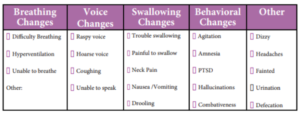Why Strangulation Occurs
Since 1987, October has been declared Domestic Violence Awareness Month (DVAM) in order to raise awareness and connect individuals and organizations who work with this issue on a daily basis. This year, the theme is “We Are Resilient.” In the United States alone, an average of 20 people per minute are physically abused by their partner.
Strangulation is a way that someone can assert power and control over their partner. An abuser thrives on power and control. They want their partner/victim to know that they can kill them at any time. The abuser can be so needy emotionally that they are very suspicious of their partners and no amount of attention from the partner can satisfy this need. Therefore, physical violence, mind games, stalking, and accusations are often a daily occurrence in order to satisfy their suspicion. 
Perpetrators have often been abused themselves as children. This is when the seed of anger and rage was planted. Or, they have watched domestic violence in their homes growing up and think that is how a relationship is supposed to work. They assume it is a normal part of a romantic relationship. Childhood trauma is a terrible thing and happens to a lot of people. However, the people who take their anger to the next level and strangle their partners are very different. These abusers had very few interactions as children with adults who modeled healthy relationships, so they were never taught how to deal with what they experienced as a child. According to one study of 300 cases where men strangled their partner, in 4 out of 10 of those cases, children were present and witnessed the event. If children are not treated for these traumas early on, they carry this baggage into adulthood and thus into dysfunctional relationships. Their parents had very dysfunctional relationships so the coping skills they learned were rooted in violence, anger, and hurt.
 Over the past 20 years, much more attention has been paid to the dangers of strangulation, one of the most lethal forms of violence, by both prosecutors and physicians. Since 2010, many states have passed laws reflecting the severity of strangulation. In some states it is considered a felony, but in others it is still a misdemeanor. Of course, if the victim dies, it also can be classified as a homicide.
Over the past 20 years, much more attention has been paid to the dangers of strangulation, one of the most lethal forms of violence, by both prosecutors and physicians. Since 2010, many states have passed laws reflecting the severity of strangulation. In some states it is considered a felony, but in others it is still a misdemeanor. Of course, if the victim dies, it also can be classified as a homicide.
The Training Institute on Strangulation Prevention defines strangulation as “the obstruction of blood vessels and/or airflow in the neck resulting in asphyxia.” Strangulation can cause severe, permanent, or fatal damage to the victim. Strangulation should never be confused with choking. Strangulation occurs from the outside of the neck using pressure to cut off oxygen flow to the brain. Choking, however, refers to something blocking the trachea from the inside, not allowing oxygen to enter the lungs. Strangulation can affect the blood flow to the brain with pressure to the carotid arteries, thus prohibiting oxygen from entering the brain. It also can cause pressure to the jugular veins which carry deoxygenated blood from the brain. It can also block the trachea and keep the victim from being able to take breaths which further impedes oxygen flow. Unconsciousness can occur within 5-10 seconds because of these mechanisms. Death can occur within a few minutes.
Of the one in four women who will experience intimate partner violence (IPV), 68% of those will suffer a near-fatal strangulation. 97% of these victims are strangled with hands. Of those, 38% report a loss of consciousness. 35% of the strangulations occur during some other type of abuse such as a sexual assault. 9% of these women are pregnant. 70% of these women report feeling that they are going to die.
This is an example of documentation used to assess for signs and symptoms of strangulation:

 Of course, there may not be any visible injuries. Law enforcement should request that a victim remove their makeup prior to examination as they may have tried to cover up old injuries. The new injuries will also be more visible this way. The statistics vary, but anywhere from 15-85% of strangulation victims have marks on their necks. Death can occur subsequent to the attack by days or even weeks due to respiratory complications and/or carotid artery dissection. A CTA of the neck should be performed to assess soft tissue injury.
Of course, there may not be any visible injuries. Law enforcement should request that a victim remove their makeup prior to examination as they may have tried to cover up old injuries. The new injuries will also be more visible this way. The statistics vary, but anywhere from 15-85% of strangulation victims have marks on their necks. Death can occur subsequent to the attack by days or even weeks due to respiratory complications and/or carotid artery dissection. A CTA of the neck should be performed to assess soft tissue injury.
It is often difficult to get these victims to cooperate with law enforcement because they fear retribution from their partners.
References
Anderson, C. (2022, May 24). What drives men to strangle and then kill women? Here’s what California counselors say. The Sacramento Bee. Retrieved from https://www.sacbee.com/news/local/article261397102.html
NCADV. (2022). 2022 Domestic Violence Awareness Month. Retrieved from The National Coalition Against Domestic Violence: https://ncadv.org/2022DVAM
NCADV. (2022). Statistics. Retrieved from The National Coalition Against Domestic Vioence: https://ncadv.org/statistics
Training Institute on Strangulation Prevention and the California District Attorneys Association. (2013). The Investigation and Prosecution of Strangulation Casess. Retrieved from https://evawintl.org/wp-content/uploads/California-Strangulation-Manual_web3.pdf
Vehling, S. (2019, Oct 16). Taking your breath away – why strangulation in domestic violence is a huge red flag. Retrieved from Mobile ODT: https://www.mobileodt.com/blog/taking-your-breath-away-why-strangulation-in-domestic-violence-is-a-huge-red-flag/
Don’t miss our newsletter! Topics covered are:
Assault / Trauma
DUI / General Medical
Child & Elder Abuse / Neglect
Mental Health / Toxicology
Sign up here.











